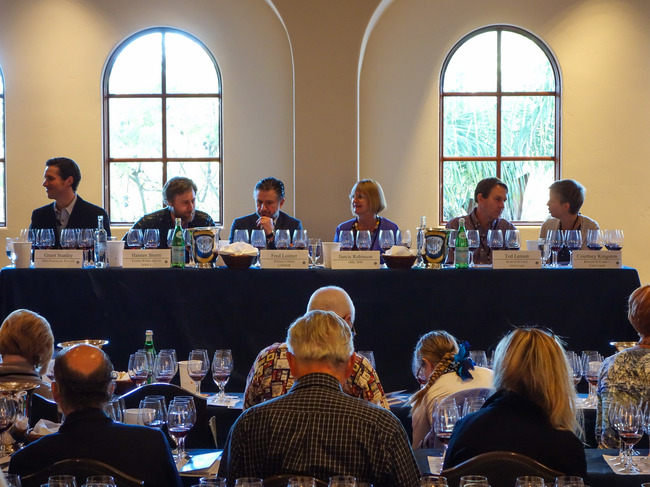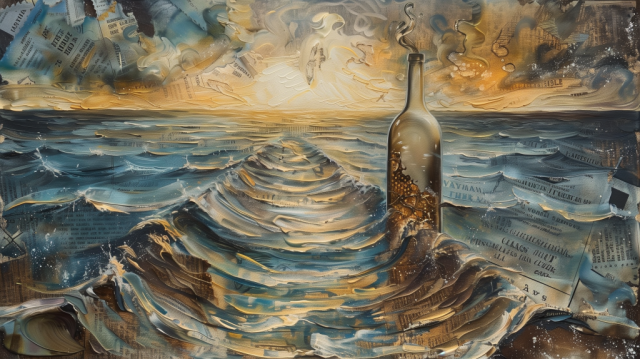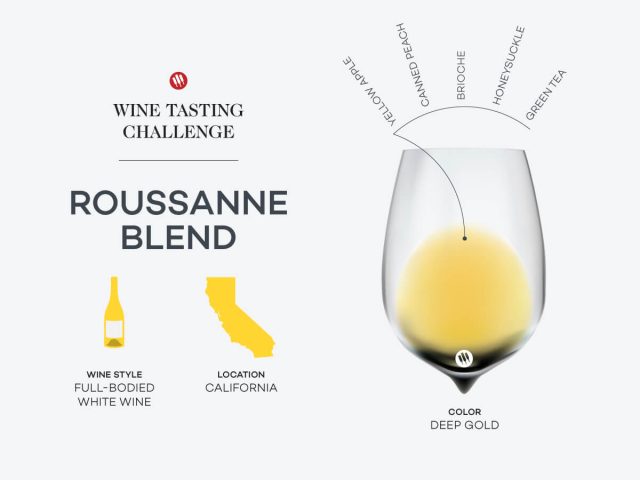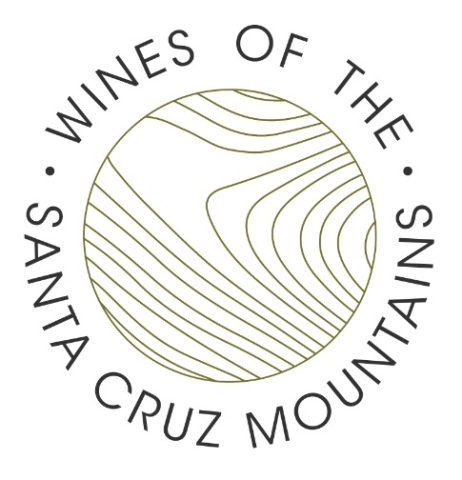The Latitudes and Longitudes of Pinot Noir

Every year, just as Winter, or what passes for winter in southern California, begins to turn the corner towards Spring, lovers of Pinot Noir gather on the cliffs of Santa Barbara for a celebration of the grape they love. The World of Pinot Noir offers three days of immersion into everything Pinot in the bucolic setting of Bacara Resort. This event has many redeeming features, but among my favorite of its many charms is the fact that the organizers make a concerted effort to recruit Pinot Noir producers from many different places around the world, and almost always have at least one event purely dedicated to showcasing the diversity of Pinot Noir.
This year’s event featured a seminar entitled “Latitudes and Longitudes: The World of Pinot Noir” led by Jancis Robinson, and featuring six producers from around the world.
Robinson began the session with a few brief remarks (which I did not entirely capture, but wrote down the following highlights:
“When I began in the world of wine, it was well accepted that Burgundy was where Pinot Noir came from. But now we have eminent examples from around the world. I hope that while you listen, today, you will be learning about what makes a great Pinot Noir, and the many variations in different parts of the world.”
“I am very lucky,” she continued, “in that every few years I update the World Atlas of Wine and the Oxford Companion, of which the Third Edition was published so long ago. Ever since then we’ve had people from around the world feeding in the changes in their regions ever since. And what I can say is that pretty much everyone has fed back the fact that in their region, the producers are making, or aiming to make fresher, lighter wines, that expressed the region rather than the winemaking.”
Robinson then proceeded to introduce each of her panelists in turn, who explained a bit about who they were, where they were from, and what they were about. Each had two wines for the audience to taste. What follows are my attempts (incomplete and spotty) to capture their remarks, and my notes on their wines.
Enjoy.
GRANT STANLEY – 50TH PARALLEL ESTATE – OKANAGAN VALLEY, BRITISH COLUMBIA
“I guess a lot of people have the perception of Canadian wine being all about cool climate areas. Our region is a cool climate but I feel I do need to dispel the myth of us living in igloos and being rootless hockey players. The Okanagan Valley is a gem, and the most consistent place to grow grapes in Canada. In some ways its an extension of the Sonoran desert. We have a lake which regulates the climate in remarkable ways. We get 10-12 inches of rain, a year, in the form of snow. Winters are pretty rough but not too rough for vinifera.”
“The valley was first planted 50 to 60 years ago. We have old Pinot and old Riesling. The lake is the dominating feature of the landscape, long and narrow stretching from the 48th to the 50th parallel. The south end of the lake valley tends to be planted with Bordeaux varietals. We’re on the north end of the valley. The soil types are perfectly suited to Pinot Noir. Volcanic and glacial movements have carved out big relief areas dominated with glacial till. We have really unusual rock formations of red granite soils that reflect light up below the canopy and help with ripening. All the vineyards are on the lake because it keeps us 5 to 7 degrees warmer in the winter, and the same level of cooling in the summer. Summers can be pretty hot and we’ve seen more heat over the years. Global warming is a fact. I’ve been there for 12 years and still trying to figure out what an atypical vintage is.”
“The wines I’m showing today are primarily from grapes that are babies. Our project began focused on Pinot Noir. We also make a little Gewurztraminer and a bit of Pinot Gris. We talk about making our wine in the vineyard.”
“Our vineyards are south-west facing, narrow plantings, with 1700 vines per acre. We end up doing all our viticulture on steep slopes with tractors. We have 6 Dijon clones planted. In Canada, we have this very strange, very lax biosecurity law that allow us to import vine material from all over the world. So we are bringing rooted vines into the country by the thousands from France.”
One of the other panel members pipes up at this moment and asks “Do you have phylloxera?” to which Stanley replies, “We have everything!”
“Those laws are going to change pretty soon,” he continues, “It has given us the opportunity to talk with people in Oregon about clonal material. Most of the suitcase clones that people talk about around here have come through Canada. It’s quite interesting that our clonal material is certified and legal.”
“We ferment our wines spontaneously, and we let them have lots and lots of time. That’s the angle and the game.”
2012 50th Parallel Estate Pinot Noir, Okanagan Valley, BC
Medium garnet in the glass, this wine smells of cranberry compote and some struck match sulferousness. In the mouth, savory notes of green olive and brown sugar mix with raspberry jam and a nice stony note underneath all the fruit. Excellent acidity. Some heat on the finish. 14{45b0463633054486b24ea7f1d8a3d5c23c88cedad61f649c1174e653e8a53946} alcohol. Score: around 8.5. Cost: $32.
2013 50th Parallel Estate Pinot Noir, Okanagan Valley, BC
Medium garnet in the glass, this wine smells of earthy raspberry and cherry. In the mouth, juicy stony flavors of raspberry and wet earth have a nice resonant depth to them. Faint, tight tannins. Good acidity. 14.5{45b0463633054486b24ea7f1d8a3d5c23c88cedad61f649c1174e653e8a53946} alcohol. Score: between 8.5 and 9. Cost: $32.
TED LEMON – BURN COTTAGE – CENTRAL OTAGO, NEW ZEALAND
“In New Zealand, Pinot Noir is concentrated on South Island with the exception of Martinborough. It is grown the full length of the South Island. Central Otago is the most southern wine region in the world today. If you ever fly in, you fly into Queenstown, and you’ll see the a set of mountains named the Remarkables out your window. Everything in Central Otago is remarkable.”
“It is the only desert region in New Zealand. It is a land of very low rainfall, but the rain is spread throughout the year. There is rain during the growing season. To understand New Zealand, you have to understand that from north to south the country is 1000 miles long, but only 230 miles wide. The wind never lets you forget that you are on an island. There is no climate, say the Kiwis, only weather. You get all 4 seasons in a day.”
“Central Otago is as dramatic or more than any other wine region in the world. We’re in the shadow of the Southern Alps which sit to the west, and rise up to 12,000 feet. We sit right between a maritime and an alpine existence. And it shows in the wine. They are very vibrant, and I find a joyousness in Central Otago pinot even when it is not very well made. That’s part of our charm, in the region.”
“Otago is young as a winemaking region. Gibbston Valley Vineyards was one of the first to start. Burn Cottage wines are from the Cromwell Basin which is a bit out of the way. Schist is the dominant rock, and it is deposited in layers, sometimes foliated, sometimes not. This primary rock interacts with river sediments, alluvials, and more. it’s a wonderful place to work. The Kiwis are an enthusiastic, hard working crew. I was brought down by the Burn Cottage owners. The vineyards are a big amphitheater, a bowl, and were planted from scratch. It is the first biodynamic vineyard in Central Otago, though Felton Road might quibble. When I first started working with biodynamics, one of the locals told me I ought to be deported.”
“The wind in this region is astounding. I don’t personally know any wine region where you can look at weather gauge in the vineyard, and over 72 hours, you’ll have winds blowing 40 to 50 kilometers per hour from the north, and then 36 hours later, blowing with the same strength from the south.”
“Who would ever suspect a region this extreme, that Pinot Noir could do so well? It is a fascinating place to grow grapes.”
2012 Burn Cottage Pinot Noir, Central Otago, NZ
Medium garnet in color, this wine smells of raspberry jam and a hint of black olives. In the mouth, wonderfully savory raspberry and red miso paste flavors have a smooth silkiness and bright juicy acidity. Excellent mineral notes underlie the wine. Very fine tannins. Nice finish. 13.2{45b0463633054486b24ea7f1d8a3d5c23c88cedad61f649c1174e653e8a53946} alcohol. Score: around 9. Cost: $55. click to buy.
2013 Burn Cottage Pinot Noir, Central Otago, NZ
Medium garnet in the glass, this wine smells of wet stones and raspberry and raspberry leaf. In the mouth juicy raspberry and cherry flavors mix with a wet stone and wet earth savoriness. Notes of dried herbs mix into the finish. Very fine grained tannins that have an athletic aspect even though they don’t muscle into the wine very much. 13.6{45b0463633054486b24ea7f1d8a3d5c23c88cedad61f649c1174e653e8a53946} alcohol. Score: around 9. Cost: $55.
COURTNEY KINGSTON – KINGSTON FAMILY VINEYARDS, CASABLANCA VALLEY, CHILE
“My great-grandfather was from the upper Peninsula of Michigan, copper country, and in 1906 he headed south to seek his fortune.”
“Chile is as long as the US is wide. The things that recently would have brought Chile to mind for people might be the miners in the north, or our earthquake in 2010 down in the South. Santiago is right in the middle of the country, and Casablanca is on the way to the coast. Chile has been making wine since 15th century. Most of our history has been with Bordeaux varieties in warmer climates, which is why people know our Sauvignon Blanc, and Carmenere. The Casablanca Valley wasn’t planted until the 80s.”
“We planted our vines in the mid Nineties. We’re just scratching the surface. In Casablanca we are quite like the south-central coast of California. When you look at the flora and fauna, they even look similar. But it is really its own animal. As opposed to Canada, we have a very strict quarantine for 2 years on any plant material we’re bringing in.”
“We have been experimenting and learning with not only Dijon clones imported, but also our own clonal material. For us it’s a clean slate, not just in terms of the vineyards but also the winemaking. In Chile most winemakers have been used to making wine on a larger scale. From an economic standpoint, historically it has been export or die. There are 18 million of us in the country. Our more populous neighbors Argentina drink a large portion of their own wine, but we can’t do that. So for a long time Chilean wines have been made in large volumes and exported.”
“We wanted to make wine in small volumes and focus on estate only. That hasn’t been easy with winemakers coming out of our schools really trained to work on larger scale. We are trying to focus just on what a couple of hands could make.”
“Water is a big constraint for us. Every year is a crazy nail-biter with frost. Our frost protection is water. Imagine yourself at 2:-00 AM on cold spring morning with the alarms going off. If you think it’s going to get colder, you turn on your precious water and you leave it on. it is a nail-biting decision.”
“Both 2011 and 2013 were cool years for us.”
2011 Kingston Family Vineyards “Alazan” Pinot Noir, Casablanca Valley, Chile
Medium garnet in the glass, this wine smells of floral raspberry and cherry aromas mixed with a hint of cedar. In the mouth, wonderfully juicy flavors of raspberry and cherry have a nice umami note to them with dried herbs and faint leathery tannins. Great acidity and length. 14{45b0463633054486b24ea7f1d8a3d5c23c88cedad61f649c1174e653e8a53946} alcohol. Score: around 9. Cost: $30. click to buy.
2013 Kingston Family Vineyards “Alazan” Pinot Noir, Casablanca Valley, Chile
Medium garnet in the glass, this wine smells of wet earth and a hint of stewed vegetables. In the mouth green wood and herbs mix with very savory notes of raspberry and cherry. Slightly funky. Score: around 8.5. Cost: $30.
HANNES STORM – STORM WINES – UPPER HEMEL-EN-ARDE VALLEY, SOUTH AFRICA
“It’s nice to be here. it’s quite interesting, before I agreed to fly to California. I was thinking of taking a break. This year was the earliest harvest in history, a full four weeks early. It was logistically a nightmare. I was winemaker at Hamilton Russell for 15 years and left in January. I started looking for great terroir, and in 2012 I stumbled on some small hidden sites in the corner of our region. I decided in 2012 to make the wine from their first vintages, and the rest is history.”
“As a wine region South Africa is 350 years old. The wine industry originated around Cape Town, firs in Constantia and those areas, then spreading to Stellenbosch. In1976, the Russells were searching for the coolest climate sites they could find for Pinot Noir, and they found sites in the Walker Bay region. It is about 16 miles southeast of Cape Town, a narrow valley with a fishing village on the sea. This narrow valley runs inland for 25 kilometer, and within it, there are three small appellations. Each has very different soil types. In the lower valley we have shale clay soils, then sandstone in the middle with more decomposed granite soils and less clay. The top is 60 meters higher in elevation and when you go to the ridge, you’ll find you get the same shale you began with again.”
“We sit on the 34th parallel and we reckon its very important for us, to measure ripening season temperatures. The average temperature of the last 10 years is 25 degrees. About like Burgundy.”
“Except we have much higher rainfall. We had 800 millimeters (31 inches) in 2014, and we had 260 millimeters (10.2 inches) in 2 days, two weeks prior to harvest, then 2 days prior to harvest, another 210 millimeters (8.2 inches). This year is ending up quite dry. That’s why we’re harvesting early this year.”
“We are about 1.2 kilometers from the Atlantic, where we have very cold water temperatures. Our yields are tiny. 1.1 tons per hectare (.5 tons per acre) for Moya and 3 tons per hectare (1.5 tons per acre) for Vrede.”
2012 Storm Wines “Moya’s” Pinot Noir, Upper Hemel-en-Aarde Valley, South Africa
Medium garnet in color, this wine smells of bright raspberry and pink peppercorn aromas mixed with hints of dried flowers. In the mouth, juicy raspberry and green herbs swirl with wonderfully minerality. Long finish, stunning acidity. Very delicious. Easily one of the best Pinot Noirs I’ve had from South Africa.12.9{45b0463633054486b24ea7f1d8a3d5c23c88cedad61f649c1174e653e8a53946} alcohol. Score: between 9 and 9.5. Cost: $50. click to buy.
2012 Storm Wines “Vrede” Pinot Noir, Hemel-en-Aarde Valley, South Africa
Medium garnet in color, this wine smells of wet earth and wet stones, and raspberry leaf. In the mouth, deep stony, savory flavors of earth and raspberry and green herbs have a fantastic brightness to them. Great acidity and faint tannins. The wine possesses a wonderfully saline quality, with a deep wet wood pungency that lingers for a while in the finish. Again, certainly one of the best Pinot Noirs I’ve had from South Africa. 13.9{45b0463633054486b24ea7f1d8a3d5c23c88cedad61f649c1174e653e8a53946} alcohol. Score: between 9 and 9.5. Cost: $45. click to buy.
FRED LOIMER – WEINGUT FRED LOIMER – LANGENLOIS, KAMPTAL, AUSTRIA
“This is the first presentation where I’m the only representative of Pinot Noir for Europe, and the only one representing the old culture of wine in Europe. In the last 30 years, everything changed in the wine world, especially in Austria. This is the work of my generation. In Austria, we drink 80{45b0463633054486b24ea7f1d8a3d5c23c88cedad61f649c1174e653e8a53946} of our production. Our wine regions are only 40,000 hectares big. It’s a little country, and 50{45b0463633054486b24ea7f1d8a3d5c23c88cedad61f649c1174e653e8a53946} is covered by the Alps. Skiing is a fact in Austria. We do that besides the wine.”
“I come from a little town called Langenlois. It’s about an hour from Vienna west along the Danube. All the wine growing regions in Austria are around Vienna. You can reach everything within 90 minutes. I am more in the northwest part, Therefore our climate is a little different. It can be hot, but generally is a very cool climate. Thanks to the Bohemian Alps. The coldest spot in Austria is 30 minutes from my house.”
“When it comes to Austrian wine, everyone knows Grüner Veltliner and Riesling, which are the famous grapes of our region. Our soils are very diverse, thanks to our geological history. The bottom of everything is primary gneiss and granite. These were covered by the sea, which laid down sand and clay. And then glaciers moved through and we have loess — glacier dust blown down from the alps. It is a very dry region. In my region there are 4000 hectares, and only 400 with irrigation. We have to farm carefully and we have to be flexible. I thought my region was extreme, but today I realize perhaps not.”
“The more fertile soils and the chalk of our region all have a high pH. We grow many whites — which make up about 80{45b0463633054486b24ea7f1d8a3d5c23c88cedad61f649c1174e653e8a53946} of the wine we make. Besides the work with Grüner Veltliner and Riesling, it is good to have a passion, and this one for me is Pinot Noir. The Kamptal region is not known for red wine. In Austria we think of Burgenland for red wine. But Pinot Noir is special, and the east is too warm for it.”
“To get out from these influences climate and soil we changed the estate in 2006 to biodynamic. When you get in trouble in New Zealand, Ted, come to Austria. Steiner was from Austria. We try to farm naturally, we farm with these principles and the reason is that the soil is most important thing. When you have a soil with life, then the soil can balance a year with 300 millimeters or 800 millimeters of rain. We do our own composting, we have a contract with farmer with animals, so we do sheep grazing in the vineyards. In the cellar we follow the ideas and try to make a minimum of intervention. It is not always “natural” winemaking, however. I think wine is a product of culture, and culture needs some guidelines and rules. Not everything is bad with technology. We are pragmatic. We want a wine that is enjoyable at the end. I hope you enjoy these wines. The year was dry, and this is our first year trying whole cluster fermentation. The 2012 we are thinking more at the level of appellation, with fruit from several vineyards. There is only an appellation system for white wines in Kamptal. So all we have is the Langenlois town on the label. But when we get good fruit in the vintage, we do single vineyard wines. The 2011 is from only one specific site. To get out the terroir expression.”
2011 Weingut Fred Loimer “Langenlois Dechant” Pinot Noir, Neiderösterreich, Austria
Light to medium garnet in the glass, this wine smells of wet earth, sour cherry and herbs. In the mouth, juicy cherry and raspberry fruit has a deep savory, almost saline quality cut with dried herbs and wet earth. Powdery tannins slightly dry the mouth. Savory and resonant. 13.5{45b0463633054486b24ea7f1d8a3d5c23c88cedad61f649c1174e653e8a53946} alcohol. Score: between 8.5 and 9. Cost: $45.
2012 Weingut Fred Loimer “Langenlois” Pinot Noir, Neiderösterreich, Austria
Light to medium garnet in color, this wine smells of dried flowers and wet earth with a hint of raspberry. In the mouth deep stony dried flowers, raspberry and raspberry leaf fruit mix with a deep wet stone minerality. Good acidity. Suede-like tannins. 13{45b0463633054486b24ea7f1d8a3d5c23c88cedad61f649c1174e653e8a53946} alcohol. Score: between 8.5 and 9. Cost: $32.
* * *
And there you have it, a whirlwind tour around the world, courtesy of Pinot Noir. Now go pour yourself a glass!
(c) Vinography: A Wine Blog – Read entire story here.




